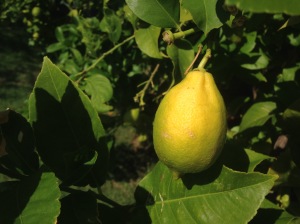As organic beings, biomarkers are always within, on and around us in everyday life. The biomarkers that I pay attention to most outside of my own body-system are often related to season/soil and agricultural biomarkers.
One such system that I care for is a Lemon-citrus tree. I transplanted this tree 5 years ago as a youngling and have maintained, monitored and pruned this tree to produce lemons of distinct and useful flavor. The breed is known as Sorrento as it is from the family of Italian lemons that of which produce the world’s tastiest Limoncelo (a refreshing, alcoholic beverage) enjoyed traditionally off the Amalfi Coast of Italy –http://www.alcademics.com/2015/03/distillery-visit-limoncello-di-capri-in-italy.html.
Each fall and spring, I attend to trimming and preparing the tree when it shows signs of adaptation to the next harvest season. Being as the “fall” and “spring” in an arid, temperate, desert climate can vary greatly from year to year, the timing for watering, fertilizing and pruning an tree or shrub can make the difference between a healthy and high volume fruit generation each season and/or a low volume and struggled fruit bearing.
Identifying with the seasonal biomarker (the sun) and it’s movement on the horizon as well as it’s intensity has suggested to me a change from the summer season to the fall. Additionally, temperatures, both in the evening as well as the afternoons have dropped significantly and are indicative of a good time for tending to the fall citrus season.
The most identifiable biomarker for citrus health and growth is the skin coloration of the fruit. The color tone ultimately provides a cue regarding it’s water allocation, soil condition and sun exposure.
In the below example, you can see where the discoloration of the fruit is suggesting a ripening fruit, it is also showing pale signs of yellow vs. a vibrant and healthy “lemony” yellow. This is a biomarker for early(pre season) fruit development.


A green lemon suggests it is unripened. The vibrancy, and plumpness of this fruit suggests a future ideal lemon is possible here. These visual “biomarkers” are critical for my ability to maintain and harvest a healthy batch of lemons this year. Albeit, not for Limoncelo (this time), rather for a nice fat lemon cake (see Food Science experiment).
Additionally, I have discovered that the current interest is in respect to identifying diseases in trees using biomarker, genetic and scientific methods:
1) Report of Suggestions on Florida’s Asymptomatic infected trees – http://www.nap.edu/read/12880/chapter/6#104
2) Point-of-use nanosensor for detection of citrus greening disease (Huanglongbing) – http://vivo.usda.gov/display/NIFA-1001907-PROJ
It would appear as though some technology exists for identifying citrus health by using computer vision as well as other technologies. Perhaps one could be developed for home gardening use? I also like the idea of designing an infographic for citrus health monitoring as in: http://www.saferbrand.com/blog/wp-content/uploads/2015/04/why-are-my-plants-yellow-safer-brand.jpg



